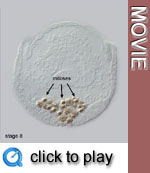Stage 8
Key
events: rapid phase of germ band extension, to 60% egg length
Stage 8 lasts for approximately 30 min (3:10-3:40 h) and comprises the
rapid phase of germ band elongation; it ends with mesodermal parasegmentation.
Mesoderm and endoderm formation have taken place during the previous two
stages by invagination of ventral furrow and the amnioproctodeum. The
cells that remain at the outer surface of the embryo represent the ectoderm
and the amnioserosa.
 The
gradual extension of the germ band over the dorsal side of the embryo
is called germ band eleongation. This movement occurs very rapidly during
its initial phase and is quite slowly during the following stages. By
the end of stage 8 the elongation has progressed to bring the posterior
tip of the germ band to about 60% egg length (0% egg length = posterior
pole).
The
gradual extension of the germ band over the dorsal side of the embryo
is called germ band eleongation. This movement occurs very rapidly during
its initial phase and is quite slowly during the following stages. By
the end of stage 8 the elongation has progressed to bring the posterior
tip of the germ band to about 60% egg length (0% egg length = posterior
pole).
 The
germ band consists of an inner, mesodermal, and an outer, ectodermal layer.
The beginning of germ band elongation coincides with profound modifications
of the mesodermal primordium. The ventral furrow closes off shortly after
invagination. The cylindrical cells of the ventral furrow are organized
in a regular epithelium during stage
7. This architecture is lost at the onset of stage 8, when the epithelium
disaggregates and all cells of the mesoderm start dividing within a very
short time. During the initial period of germ band elongation, all mesodermal
cells perform two consecutive, parasynchronous mitoses, while the ectodermal
cells immediately adjacent to them remain mitotically quiescent.
The
germ band consists of an inner, mesodermal, and an outer, ectodermal layer.
The beginning of germ band elongation coincides with profound modifications
of the mesodermal primordium. The ventral furrow closes off shortly after
invagination. The cylindrical cells of the ventral furrow are organized
in a regular epithelium during stage
7. This architecture is lost at the onset of stage 8, when the epithelium
disaggregates and all cells of the mesoderm start dividing within a very
short time. During the initial period of germ band elongation, all mesodermal
cells perform two consecutive, parasynchronous mitoses, while the ectodermal
cells immediately adjacent to them remain mitotically quiescent.
Most of the cells in the walls of the pocket formed by the proctodeal invagination divide at this stage.
Signs of increased mitotic activity
are visible within the ectodermal germ layer, mainly anterior to the cephalic
furrow, in the territory of the procephalic lobe.
![]()
Media list
Genes discussed
|
Gene
|
Gene product - Domains
|
Function
|
Links
|
|
twist (twi)
|
transcription factor - bHLH
|
required for mesoderm development, high Twi levels
block formation of visceral mesoderm and heart and induce somatic
myogenesis
|